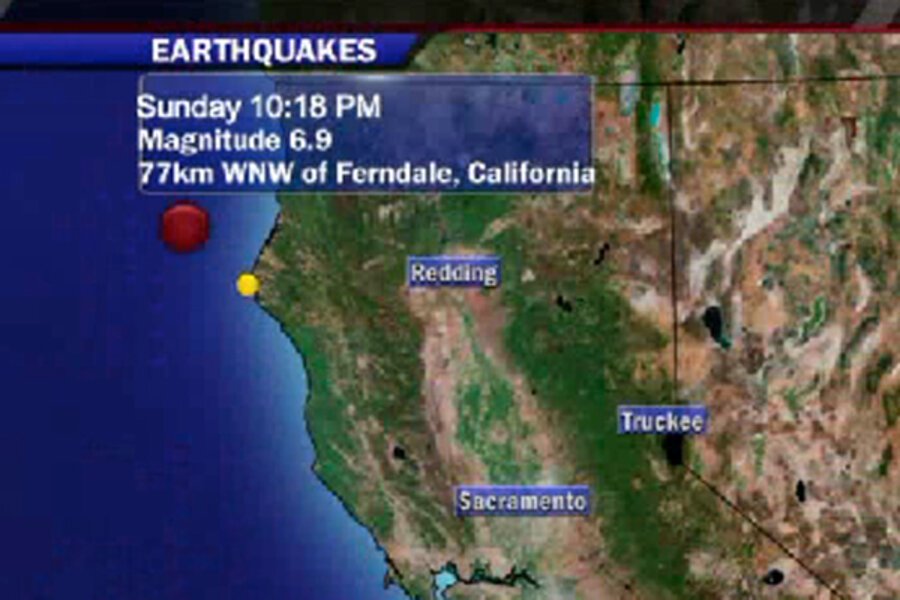California earthquake: 6.8 temblor erupts from hot spot off northern coast
Loading...
A strong earthquake shook the northern California and southern Oregon coasts Sunday night, causing frayed nerves, little damage, and a renewed respect for a shifting, postage-stamp patch of offshore crust known as the Gorda plate.
The magnitude 6.8 temblor struck at 10:18 p.m. Pacific Daylight Time some 52 miles west of Eureka, Calif., just north of Cape Mendocino. The offshore region, known as the Mendocino Triple Junction, is a hotbed of earthquake activity thanks to the motions of the three tectonic plates that meet there.
The temblor and at least 13 aftershocks were triggered by a rupture along a fault on the Gorda plate, which is slowly sliding underneath the northern California and southern Oregon coasts – a process that over the last 600,000 years built California's Mt. Shasta and Mt. Lassen volcanoes.
More than 4,000 people reported feeling the quake, according to shake reports submitted to the US Geological Survey. The most intense shaking occurred around Cape Mendocino's immediate area. But reports also came from as far north as Eugene, Ore., as far south as the northern end of San Francisco Bay, and as far east as Lake Tahoe.
As the the seismic waves traveled from the epicenter, they triggered a swarm of tiny quakes underneath a geothermal power plant 70 miles north of San Francisco, according to David Oppenheimer, with the US Geological Survey office in Menlo Park., Calif.
The Mendocino Triple Junction has a long history of triggering strong to major earthquakes. Since 1900, five quakes with a magnitude of 7.0 to 7.3 have occurred within about 60 miles of the epicenter of Sunday's quake. In addition, in 1992, the Gorda plate's movement beneath the North American plate triggered a magnitude 7.2 temblor beneath Petrolia, on Cape Mendocino, as well as quakes farther inland.
Indeed, the Gorda plate – often considered the southern section of the Juan de Fuca plate, which is sliding beneath the Oregon and Washington coasts – is one stressed piece of underwater real estate.
Since 1976, the plate has been the site of 20 earthquakes with magnitudes of 5.9 or higher, the most active site for large earthquakes in the contiguous United States, according to researchers John Rollins of the University of Southern California and USGS colleague Ross Stein.
As the Pacific Plate creeps north toward Alaska along the San Andreas Fault, it collides with the Gorda plate. There, the San Andreas abruptly ends. The collision, which has fractured the sea floor for more than 1,400 miles west of Cape Mendocino, puts the squeeze on the Gorda plate. The plate's eastward movement as it dives beneath the North American plate adds additional stress. As if to add insult to injury, the Gorda plate is sliding beneath a North American plate headed southwest.
The combined stresses build on faults that lace the Gorda plate and find release in quakes like the one that occurred Sunday.
The nature of the triple junction and and the epicenter's distance from the northern end of the San Andreas suggest that Sunday's quake is likely to have had little or no effect on the northern end of the fault, Mr. Oppenheimer notes.
Indeed, stress on the northern end "might even have been decreased," he says.








